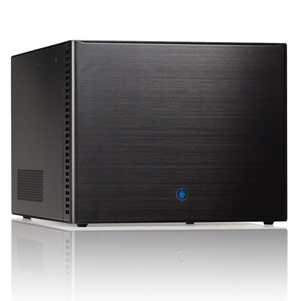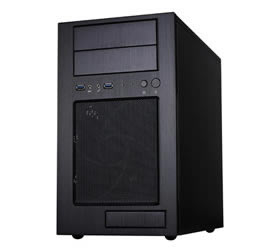File Server Builder's Guide
by Zach Throckmorton on September 4, 2011 3:30 PM ESTAs motherboard layout is important in ensuring that airflow is as unobstructed as possible, case design is also critical in facilitating excellent airflow. If you're building a system with one or two hard drives, most cases work fine for a home file server - just make sure there is a fan near the hard drive(s) so it is not sitting in stagnant air. However, if your server requires multiple disks, here are a few cases that work especially well for file servers.
Mini-ITX

Fractal's Array R2 is a nearly perfect home file server case. At less than 14" deep by 10" wide by 8" tall, it occupies little volume. It positions a removable hard drive cage immediately behind a quiet yet powerful 140mm intake fan. The hard drive cage accommodates up to six hard drives using vibration-dampening silicone mounts, and there is also room for a 2.5" drive (either an SSD or HDD). According to my testing, when stuffed with six low-rpm 2TB mass storage HDDs and one SSD (with an Intel Pentium G620 CPU installed), the temperatures of the HDDs hover around 40C even when all drives are under artificial sustained load (using Iometer). The PSU is a custom SFX form factor model, 80+ efficiency 300W unit with ample amps on the split 12V rail to power six HDDs. The PSU features seven SATA connectors and one legacy molex connector, so there are no extraneous molex plugs and enough SATA plugs. Furthermore, the cables are shorter than typical, so excessive cabling does not interfere with airflow. The case itself is constructed of aluminum so it is lightweight, and its overall build quality is very high. It does not have room for an optical drive, but I consider optical drives superfluous for a home file server. If necessary, you can always hook up a USB interface external optical drive. The only drawback of this case and its PSU is the price: at just under $200, it is not cheap. However, the subjective aesthetics, objective functionality of the case and the custom PSU are worth the cost if you want a small but capacious home file server case.
Micro-ATX

As I prefer home file servers that take up as little space as possible, Silverstone's TJ08B-E is a great, smaller micro-ATX minitower. It's less than 16" deep, 9" wide, 15" tall and weighs less than 12 pounds. It can accommodate up to five HDDs plus one SSD. As with the Fractal Array R2, the hard drives are placed immediately behind a front intake fan - though in this case, it's an even larger 180mm unit. The TJ08B-E is flexible in that it can hold a couple optical drives as well as a GPU in case you want to repurpose or multipurpose it. When stuffed with four low-rpm green drives, the temperatures under load don't exceed 45C during sustained transfers. Overall build quality is very good, like most Silverstone cases.
Silverstone makes a diminutive, fully modular PSU that makes working with smaller cases like the TJ08B-E, Lian Li PC-Q08, and others much easier. Silverstone also offers a short cable kit, making the ST50F-P PSU even better suited to SFF cases. Finally, it's clear that Silverstone had smaller multi-HDD systems in mind when designing the CP06 SATA power plug extension cable. This extender connects to a single SATA power plug and then has four SATA power plugs that are spaced closer than usual together, further reducing cable clutter. Though the cost of these accessories adds up, they make an ideal cabling solution very easy to implement. Regardless of whatever PSU you decide to go with, if you use a split 12V rail model, make sure you don't load up one rail with HDDs. If you go with a single 12V rail model, you'll want that rail to be beefy - for example, don't try to put ten HDDs and four case fans on a budget PSU with a 20A 12V rail.
Full Tower
Very few cases can accommodate ten HDDs at stock (without adding adapters), and such cases are not at all small. Full towers also typically offer excellent airflow, and cable management is not very difficult. Fractal's Define XL is one of the least expensive 10 HDD bay full tower cases available. It is well-built, and extra care has been paid to making the case quiet in the form of panel insulation. It is impossible to hear active HDDs inside this case even when you're sitting just a few feet from it (even the notoriously loud VelociRaptors). Further, there are plenty of integrated niceties like adjustable/flexible cable baffles that assist in cable management. Seven of the ten HDD slots are immediately behind fans, with three slots one cage removed from the front intake fans. Even still, the HDDs that aren't right behind the fans stay cool (between 35C and 40C). At around $150, it is an excellent value. Just make sure you don't pair it up with Silverstone's short cable kit!
We've saved the most important aspect of a home file server - the hard drives - for the next and last component page.











152 Comments
View All Comments
GTaudiophile - Tuesday, September 6, 2011 - link
I would be curious to know which type of RAID you all run. Perhaps we could do a poll?I assume that the three most popular types of RAID are RAID 0, RAID 5, RAID 1.
I personally use RAID 1 and wonder why people poo-hoo it so much. I use it strictly as a backup+file hosting solution.
GTaudiophile - Tuesday, September 6, 2011 - link
I should add ZFS to the list as well...RAID 0
RAID 5
RAID 1
ZFS
compudaze - Tuesday, September 6, 2011 - link
ZFS is a file system like EXT4, UFS or NTFS. RAID-Z [or RAID-Z1] could be considered the ZFS equivalent of RAID-5 while RAID-Z2 would be the ZFS equivalent of RAID-6.jtag - Tuesday, September 6, 2011 - link
For my (Linux) storage server I have a RAID6 with a hot spare. I started with RAID1 of two 2TB drives on this machine, added a third drive and converted to RAID5 with a reshape command a year later, then added two more drives and converted to RAID6 with another reshape, and finally added a hot spare a few months ago. The machine itself had a CPU upgrade (single core to two core) and a SATA card added when I moved to RAID6.There's nothing wrong with RAID1, it depends on your application - it didn't really make sense to continue with RAID1 when I started expanding my storage array, but my /boot partition is a small RAID1 at the start of all 5 active drives; if any drive fails, my machine should still boot. Grub (or I suspect any boot-loader) can't boot from a striped software RAID array. My Windows workstation is configured with a (hardware) RAID1, which paid off pretty quickly as one drive failed within weeks of getting it. My latest build has an SSD boot drive, so no RAID at all there.
Slaimus - Tuesday, September 6, 2011 - link
For a server that is expected to have long uptimes, a benefit of running the Athlon II is that it is the only one in the review that supports ECC memory. Intel forces you to buy a Xeon to get ECC support.There is a reason all business file servers have ECC memory.
Vepsa - Tuesday, September 6, 2011 - link
I used to use WHS v1, but when DE was removed from WHS 2011 I went looking for an alternative. I settled on Amahi. Runs on top of Fedora 14 (until 16 is final). Great product, fast & does more than just serve files.http://amahi.org
sligett - Wednesday, September 7, 2011 - link
A newcomer to the "file server" OS stable is Resara Server. They offer a community version (free) as well as a supported version. See resara.org or resara.com. It's available as a VM or for Ubuntu. Administer it from Windows, Mac, or Linux. I'm using it for my Windows 7 clients.dalmar72 - Wednesday, September 7, 2011 - link
Unraid is also very simple to setup, it does cost money once you get past 3 drives, but not having to deal with hardware raid, and if you do lose more than one drive in an array, you don't lose everything. Alos you can grow the array at any time.somedude1234 - Wednesday, September 7, 2011 - link
I wanted to build a proper NAS to displace the expsnding pile of USB and eSATA attached HDDs that was becoming unmanagable. At the same time I needed to build a triple-head workstation. With VMware ESXi I was able to build a single system that does it all.Operating System / Storage Platform: VMWare ESXi / NexentaStor Community Edition (VM)
CPU: Intel Xeon X3440
Motherboard: SuperMicro X8SIA-F
Chassis: Antec 900 v2
Drives: 5x Samsung F4 HD204UI (data), 1x OCZ Vertex2 60GB (ESXi OS drive)
RAM: 16GB (4x Kingston KVR1066D3Q8R7S/4G)
Add-in Cards: Promise SATA 300 TX4, AMD Radeon 6850
Power Supply: Seasonic SS-560KM
Other Bits: Sound Blaster X-Fi Surround 5.1 Pro (USB Sound Card)
Usage Profile: Home NAS, streaming media server, video transcoding, primary workstation
Virtual Machines:
- NexentaStor Community Edition (VMDirectPath for the on-board SATA controller)
- Ubuntu 10.10 (32) running PS3 media server
- Windows 7 Ultimate x64 (VMDirectPath for the AMD Radeon 6850 and one of the on-board USB controllers)
The 5x Samsung 2TB drives make up a RAIDZ1 in Nexenta which is exported back to ESXi via NFS and to the rest of the network via CIFS. The Antec 900 lets me upgrade to a total of 15x drives over time by using 5-in-3 backplanes. At that point I'll install a SAS controller and pass that through to the storage VM.
This is well overkill for just a file server, but for my needs it's been perfect. As an added bonus, I can reboot the Windows 7 workstation and/or Ubuntu VM's without affecting network access to the big data shares.
masterbm - Thursday, September 8, 2011 - link
One thing I did is I built my file server into a Media center pc. Actually the original version was for just media center pc. The old version still functions as bedroom media center 1 tv tuner no hd.My build which has been running for almost 2 years nonstop is
amd 620
Gigabyte board am2+ with amd 780 chipset.s
4 gb ddr 2 800 (2 2 gb sticks)
zalman butterfly cooler for cpu.
1 250 ide 7200 for boot drive( still using the orinigal format from the old machine)
1 ide dvd drve
4 2tb sata stoarge drives
1 750 gb drive for music and tv record data
2 ati 650 tv tuners both have ditgial cable box connected to them and the rf adatapter to run boxes) also both hd inputs are connected. Thought the rf adapter would be unstable but after some setup issue work fine for 4 months now.
usb remote control.
wireless keyboard and mouse
then connected to 5.1 amp optical
then connected to 1080 tv via usb using the onboard 4200 graphics (128 side port memory)
I very much love this setup cpu has plenty of horse power to do media center play hd content effortless.
I also enable muitlply rdp connections so I can admin box though another terminal. Or setup to encode videos.